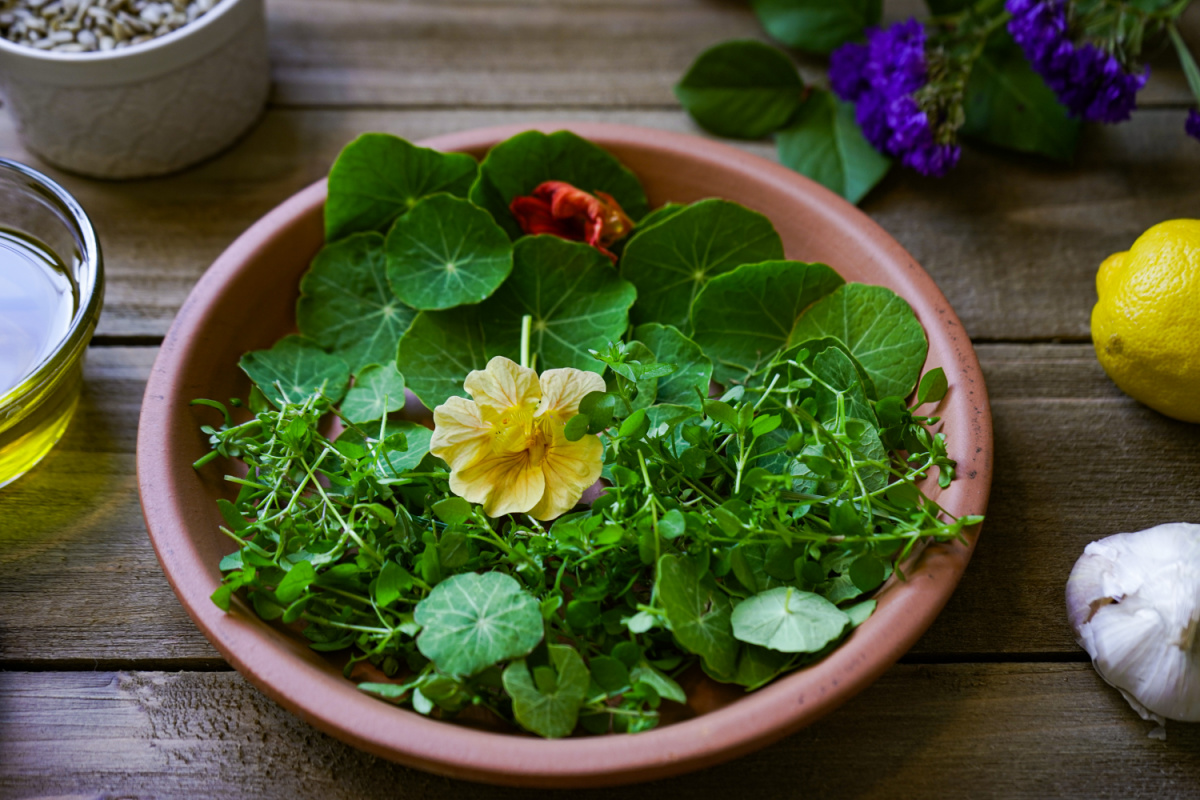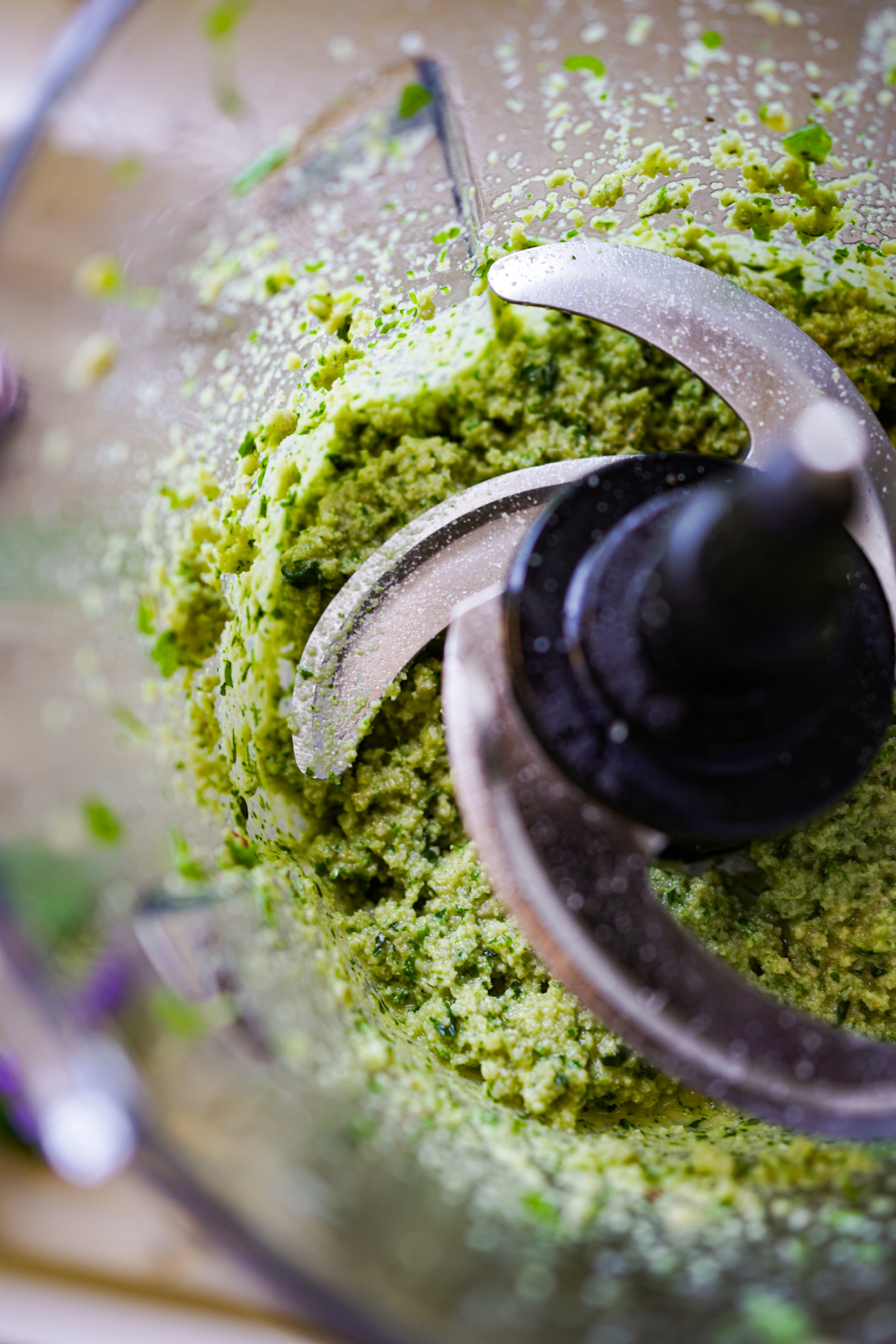
Chickweed Pesto: How to Make This Wild Greens Recipe
Chickweed (Stellaria spp., including Stellaria media) is one of the first herbs to appear each spring. If you’ve been cooped up inside all winter and you’re ready to hit the forests and meadows the minute the weather warms, then chickweed is a fantastic edible green to learn how to recognize and use in herbal recipes, like chickweed pesto!
Chickweed is best to use fresh, as the juicy leaves and stems shrivel up into almost nothing when dried. It’s also not an herb that you can typically find in grocery stores or markets, so you’ll likely need to learn how to identify it in the wild—or grow it yourself—if you want to enjoy it.

How to Use Chickweed
Chickweed has a mild, grassy, somewhat salty flavor that is sometimes compared to corn silk. In the kitchen, chickweed is easy to mix into fresh salads or to use as a topping on sandwiches, tacos, and other dishes. It also tastes delicious added to steamed greens and can be stirred into warm soups and stews. Infusing chickweed in vinegar is a popular way to capture its beneficial minerals and vitamins for year-round use, but my favorite way to use this all-star wild green is in chickweed pesto (recipe below).
In the apothecary, chickweed is a superb lymph tonic and supports the kidneys (Groves, 2016). Because of this role—and its availability in early spring—many herbalists see it as a beneficial herb that can help clear out the heaviness of winter and prepare the body for warmer months ahead.
Chickweed is moistening and cooling, not only as a food, but also when used topically. You can whip up a chickweed compress or poultice to soothe dry itchy skin or rashes.
The aerial parts (leaf, stem, and flower) of fresh chickweed can be tinctured, and juicy chickweed is also a prime choice for a succus—an herbal juice that’s preserved with alcohol for a longer shelf-life.

How to Identify Chickweed
Chickweed comes and goes quickly each spring and fall, so you’ll want to have your eyes open and act quickly when it makes an appearance. Stellaria media is the common chickweed found in abundance.
Chickweed is an annual that grows in fields, along roadsides or trails, and in areas where the soil has recently been disturbed. It rarely grows taller than 1 foot, and the slender green stalks often form a sort of low-growing, dense nest. Chickweed leaves are oval-shaped with a pointed tip, and small hairs wind their way up the rounded stem.
Mature chickweed plants have a tiny, star-shaped white flower at the tip. Chickweed has a shallow root system and is easy to pull up (Cornell, n.d.); however, you will only need to trim off the aerial portions for your herbal prep.
Poisonous look-alike: When foraging for chickweed, you do need to be aware of its poisonous look-alike, scarlet pimpernel (Anagallis arvensis), which looks very similar to chickweed and has salmon-colored, red, blue, and sometimes white flowers. One way to tell them apart is their stems—chickweed has round stems whereas scarlet pimpernel has square stems. Scarlet pimpernel is poisonous when consumed, and it can irritate the skin and cause a rash when touched (Gardening Know How, 2021).
Growing Chickweed
If you’re not able to find or identify chickweed near you, then consider growing your own plants in your garden or in pots. Chickweed prefers cool soils and can be grown as far north as the Arctic (Strictly Medicinal Seeds, n.d.). It flourishes in rich soils that have been heavily composted or covered with manure.
You can purchase chickweed seeds from Strictly Medicinal Seeds, a wonderful family-operated seed company that specializes in beneficial herbs.



Chickweed Pesto Recipe
Making pesto is a wonderful way to take advantage of the nutritious benefits and delicious flavor of chickweed. If you have access to a large chickweed patch, then double or triple this recipe and freeze some for later. There’s nothing like the taste of spring to enliven your palette and remind you of sunshine during the cold, winter months.

This recipe also includes nasturtiums and garlic chives, two other delicious spring greens that typically make their appearance around the same time that chickweed is in season. If you don’t have access to fresh nasturtiums, then you can swap dandelion leaves, parsley, or arugula in their place.
½ cup sunflower seedsChickweed Pesto
2 tablespoons lemon juice
Zest from one lemon
1 garlic clove, peeled and chopped
½ cup olive oil
2 cups chickweed (Stellaria spp.) leaf, stem, and flower
1 cup nasturtium (Tropaeolum spp.) leaf and flower
¼ cup garlic chives (Allium tuberosum)
Tamari, salt, and pepper, to taste
There are so many ways you can enjoy your homemade chickweed pesto, from spreading it on toast, adding it to soups and stews, and drizzling it over salad greens, egg or bean dishes, pasta, and quinoa. Add a bit of vinegar to your pesto to turn it into a fresh salad dressing, or spread it on pizza instead of tomato sauce. For a special treat, use it as a substitute for mayonnaise on sandwiches or serve it to guests with crackers and raw veggies.
Fresh pesto usually lasts in the fridge for about 5 days. If you want to freeze extra, then consider scooping the pesto into an ice cube tray so you have small, individual pesto cubes. This makes it easy to pull out a few cubes at a time to add to soups and sauces throughout the year.

In Closing,
Have fun with this chickweed pesto recipe, and feel free to make it your own by swapping in different greens and spices. Parmesan cheese is a popular ingredient in pesto that you can add (or try nutritional yeast for a vegan option). With time, you will develop your own pesto recipes using the foraged, seasonal herbs that you and your family enjoy most.
I’ve been finessing my herbal pesto recipe for years, and I have quite a few wonderful recipes on my personal blog at www.KamiMcBride.com, including:
Pesto For All Seasons (ebook)
Fresh Oregano Pesto Recipe
Lemon Balm Cilantro Pesto

REFERENCES
Common chickweed. (n.d.). Cornell University. https://blogs.cornell.edu/weedid/common-chickweed/
Carroll, J. (2022, March 22). Scarlet pimpernel control: Tips for scarlet pimpernel weeds. Gardening Know How. https://www.gardeningknowhow.com/plant-problems/weeds/scarlet-pimpernel-control.htm#:~:text=Scarlet%20pimpernel%20looks%20a%20lot,and%20square%20on%20scarlet%20pimpernel
Groves, M. (2016). Body into balance: An herbal guide to holistic self-care. Storey Publishing.
Chickweed, Common (Stellaria media) seeds, organic. (n.d.) Strictly Medicinal Seeds. https://strictlymedicinalseeds.com/product/chickweed-common-stellaria-media-packet-of-100-seeds-organic/








